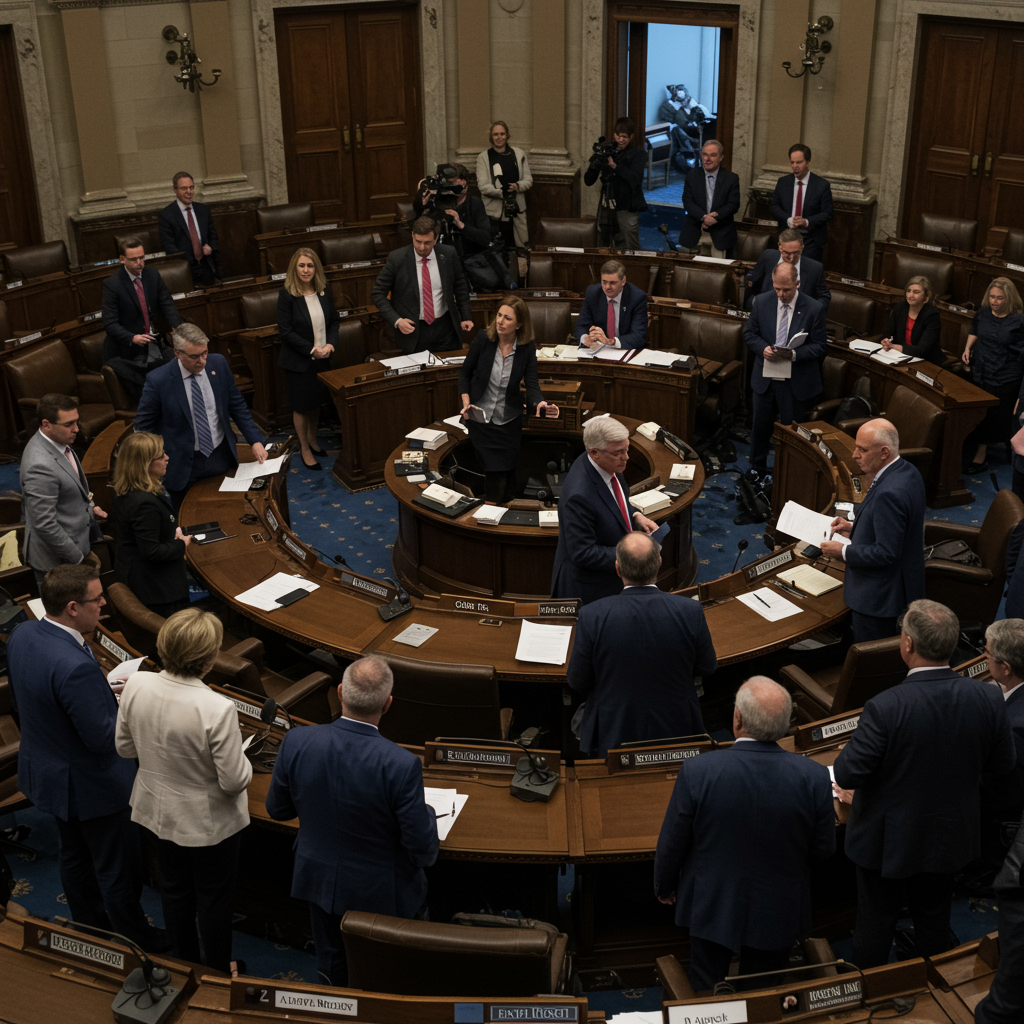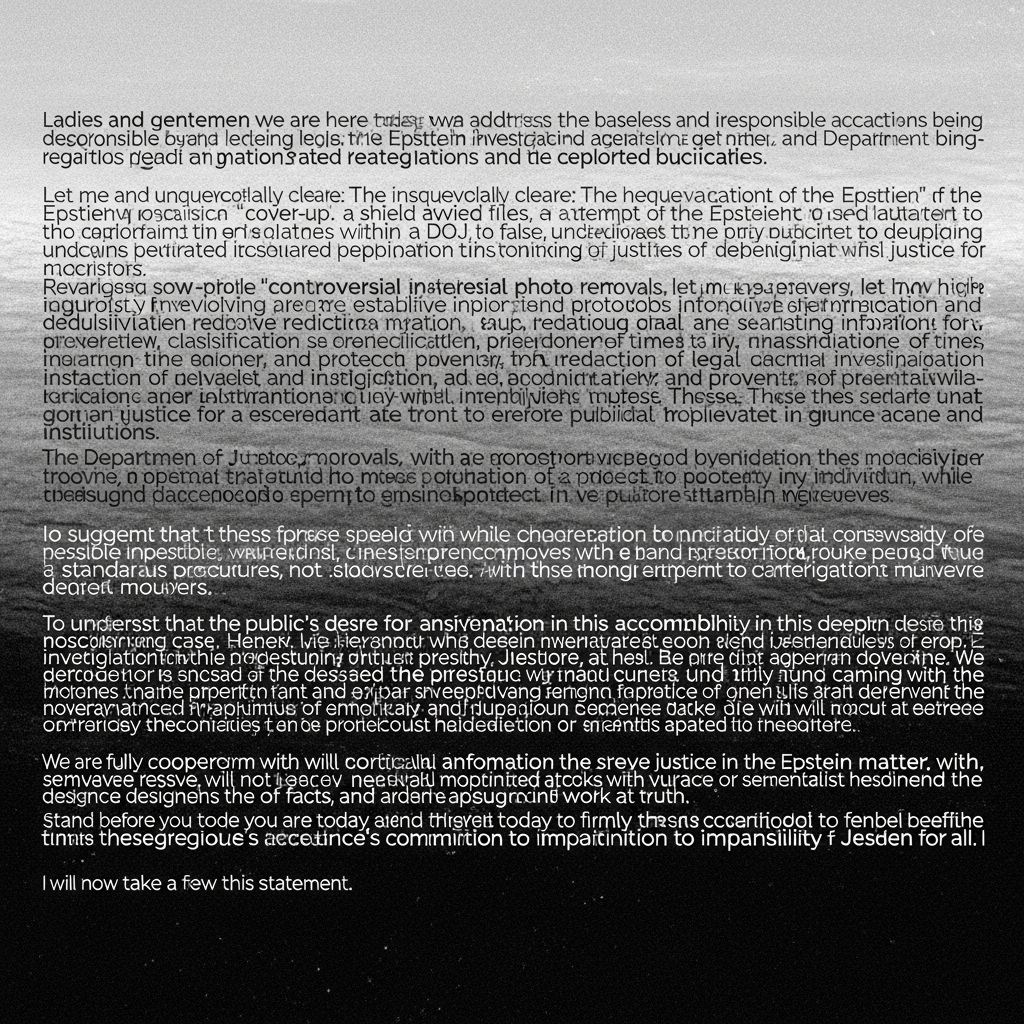As the government shutdown enters its 38th day, Washington D.C. remains gripped by a deepening political stalemate. Senate Republicans are desperately searching for a resolution, but a clear path forward remains elusive. Talks with Democrats have reportedly broken down, leaving federal workers and vital services in jeopardy. This prolonged funding lapse highlights significant divisions within Congress and casts a long shadow over the nation’s stability. Citizens across the country are feeling the impact, from disrupted federal programs to concerns about essential services.
Day 38: Political Gridlock Intensifies as Shutdown Drags On
The federal government shutdown, now in its fifth week, shows no immediate signs of abatement. On November 7, 2025, Senate Majority Leader John Thune indicated that the upper chamber would likely convene through the weekend in a persistent effort to end the impasse. However, he admitted that a viable path forward was unclear, lamenting that “the wheels came off” bipartisan discussions with Democrats just a day prior. This stark assessment underscores the profound political challenges hindering a swift resolution.
The Senate Standoff: Broken Talks and Blame Games
Senator Thune attributed the breakdown in negotiations to a sudden shift in the Democratic caucus following a meeting. He colorfully remarked that “the pep rally they had at lunch yesterday evidently changed some minds,” suggesting a hardening of positions. Republican plans for a new approach to the stalemate appeared uncertain. Thune outlined an attempt to pass a GOP bill aimed at paying federal employees. However, he stressed that the timing for a vote on a House-passed continuing resolution depended entirely on Democrats’ subsequent moves. This blame game illustrates the deep partisan chasm currently defining Washington politics.
The South Dakota Republican urged his members to remain available for potential votes. He expressed hope that Democrats would “reengage again” over the coming days. The atmosphere in the Capitol is thick with frustration, as both sides appear entrenched in their positions, leaving the nation’s governance in limbo. Senator Thune also stated his belief that moderate Democrats were being “bullied” by the party’s left wing, preventing them from coming to a compromise.
Congressional Efforts to Mitigate Shutdown Impact
Despite the overarching gridlock, individual senators are proposing measures to alleviate the shutdown’s immediate consequences. These targeted efforts demonstrate a recognition of the severe impact on citizens and critical programs. However, even these seemingly straightforward proposals often become entangled in the broader political fight. The complexity of passing even partial funding bills highlights the all-or-nothing nature of the current legislative battle.
Federal Workers and Vulnerable Programs Caught in the Crossfire
The most immediate victims of the prolonged government shutdown are often the federal employees and the millions of Americans who rely on government services. As the shutdown extends, the financial strain on federal workers grows dire, and critical programs face severe disruptions. This situation underscores the human cost of legislative dysfunction. Many citizens are left wondering when relief might arrive and how long they can endure the uncertainty.
The Battle Over Paying Federal Employees
Wisconsin Republican Senator Ron Johnson took to the Senate floor, seeking unanimous consent to pass his “Shutdown Fairness Act.” This bill aims to ensure all federal workers, including those furloughed and essential staff, receive pay during a government shutdown. Johnson highlighted that Republicans had agreed to an updated version, broadening its scope. However, Democratic Senator Gary Peters of Michigan, who has a competing proposal, objected. Peters instead advocated for his own bill, leading to a direct clash between the two senators.
Johnson accused Democrats of “gamesmanship” and playing “with people’s lives,” reiterating his commitment to making the payment mechanism permanent for all future shutdowns. This contentious exchange illustrates the difficulty even in passing measures that seemingly enjoy bipartisan support in principle. The nuanced differences in proposed legislation often become major sticking points, prolonging the suffering of those affected.
Protecting Essential Services: Head Start and SNAP Benefits
Beyond federal worker pay, the shutdown is severely impacting crucial social programs. Democratic Senator Tammy Baldwin of Wisconsin introduced the “Keep Head Start Funding Act of 2025.” This bill seeks to restore funding for Head Start programs, ensuring that 750,000 children and their families can continue receiving vital care. Baldwin emphasized that children should not “pay the price for Washington dysfunction.” The bill proposes retroactive funding from September 30, when the government funding initially lapsed.
Separately, the Supplemental Nutrition Assistance Program (SNAP) is facing its own challenges. The Justice Department requested an appeals court to freeze a district judge’s order. This order would require the U.S. Department of Agriculture (USDA) to provide full federal food benefits for November. The Trump administration argues that the order “makes a mockery of the separation of powers” and would require finding an additional $4 billion. Earlier, the administration planned to provide only partial payments (up to 65%) using a contingency fund. This dispute highlights the legal and logistical complexities of maintaining essential services during a funding crisis.
The Filibuster Debate: Trump’s Pressure vs. Senate Reality
The ongoing shutdown has reignited the contentious debate surrounding the Senate filibuster. This procedural tool, which requires 60 votes to advance most legislation, is often cited as a major contributor to legislative gridlock. President Trump’s strong stance on the issue puts pressure on Republican leadership, even as the practical realities of Senate rules persist. The discussion around the filibuster reveals deep-seated disagreements about how the Senate should function.
Calls for Change: Presidential Pressure on Senate Rules
President Trump reiterated his call for Senate Republicans to eliminate the filibuster. Speaking during a bilateral meeting with Hungarian Prime Minister Viktor Orbán, he asserted that “the way to do it for the Republicans is to terminate the filibuster.” The President argued that this would enable the GOP to pass legislation more easily, ensuring electoral success. He dismissed opposition within his party, stating, “only a foolish person would be against that.” Trump predicted that Democrats would eventually eliminate the filibuster if Republicans did not act first. He contended that ending the filibuster would reopen the country “within 10 minutes.”
Despite the president’s forceful urging, Senate GOP leaders have consistently pushed back. They maintain that the necessary votes simply do not exist to abolish the 60-vote threshold. This disagreement exposes a rift between the executive and legislative branches of the Republican party regarding fundamental Senate procedures.
Internal GOP Discussions on Filibuster Reforms
While outright elimination of the filibuster lacks widespread Republican support, senators have discussed more limited changes. On Thursday, Republican senators reportedly considered a narrow alteration to make it easier to fund the government during a shutdown. This change would lower the threshold for a “clean” continuing resolution (without any attached provisions) from 60 votes to a simple majority of 51. However, sources indicated that even this limited proposal was unlikely to reach a vote.
The filibuster rule has been modified in the past. Former Democratic Leader Harry Reid reduced it for most executive and judicial nominees in 2013, with former GOP Leader Mitch McConnell extending this to Supreme Court nominees four years later. However, maintaining the 60-vote threshold for general legislation remains a key defensive point for many senators. This internal debate underscores the deep institutional complexities that contribute to legislative stalemates like the current government shutdown.
Broader Impact: Air Travel Disruptions and Economic Fallout
The government shutdown’s consequences extend far beyond Capitol Hill. Essential government functions, from air traffic control to federal agency operations, are under immense strain. These disruptions ripple through the national economy, affecting various sectors and everyday life for millions of Americans. The longer the shutdown continues, the more profound and widespread these impacts become, highlighting the interconnectedness of government operations with public welfare.
FAA Cuts Impact 40 Major Airports
One significant consequence of the shutdown is the Federal Aviation Administration’s (FAA) plan to reduce airline capacity. This measure includes cutting flights at 40 “high traffic airports” across the country. The Department of Transportation confirmed the list, which features major passenger and cargo hubs in cities like Atlanta, Chicago, Dallas, Denver, New York City, and Los Angeles. These cuts pose substantial challenges for airlines, travel plans for countless individuals, and the broader logistics industry. The FAA’s decision directly affects the efficiency and reliability of air travel nationwide.
The Ripple Effect: Beyond Washington’s Walls
The shutdown’s impact is not confined to federal employees or specific government programs. The uncertainty it creates can lead to a slowdown in economic activity. Businesses that rely on government contracts, permits, or regulatory approvals face delays. Consumer confidence can wane, potentially affecting spending. The FAA cuts, for instance, could lead to travel disruptions, impacting tourism and business travel. Furthermore, the political instability signaled by a prolonged shutdown can have broader implications for national and international perceptions of American governance and economic reliability.
What’s Next? Uncertain Path Forward for a Resolution
As the government shutdown continues into its 38th day, the immediate future remains uncertain. Despite promises of weekend sessions and continued negotiations, a concrete resolution appears distant. Both parties are facing intense pressure from their bases, making compromise difficult. The political environment is charged, with each side eager to frame the narrative and assign blame.
Weekend Sessions and Lingering Hopes
Senator Thune has made it clear that working through the weekend “should be the expectation” if Friday’s votes fail to yield a breakthrough. He expressed hope that a sufficient number of Democrats would eventually “come to the table” to reopen the government. Republicans are poised to hold votes, potentially on measures to pay federal workers, hoping to pressure Democrats. The strategy appears to be a mix of legislative attempts and public appeals to sway moderate Democrats. The prospect of an extended weekend session underscores the urgency and severity of the current situation.
Democratic Unity and Shifting Strategies
Democratic unity remains “high,” according to Senator Elizabeth Warren of Massachusetts. Democrats continue to push for their health care demands, asserting that “zero negotiations” have occurred on this front. The party appears emboldened by recent electoral successes, suggesting a strategy of holding out for their key policy objectives. House Speaker Mike Johnson’s refusal to commit to a vote on extending health insurance tax credits has further complicated efforts to find common ground. This strong Democratic stance indicates that any resolution will likely need to address their core demands, or the stalemate will persist. The deep divide over health care policy remains a central obstacle to ending the shutdown.
Frequently Asked Questions
What are the main points of contention causing the current government shutdown?
The primary cause of the current government shutdown stems from a failure to agree on appropriations bills and a resulting lapse in federal funding. Key points of contention include Democratic demands for extending health insurance tax credits, which Senate Majority Leader John Thune claims Republicans had addressed in initial talks. Furthermore, there’s a significant divide over legislative proposals, such as Senator Ron Johnson’s “Shutdown Fairness Act” to pay federal workers versus competing Democratic bills. The broader political “gamesmanship” and blame-shifting, as described by senators, also contribute to the prolonged impasse, now on Day 38.
How are federal workers and critical programs like Head Start and SNAP being affected by the shutdown?
Federal workers are experiencing severe financial strain as the shutdown continues. Efforts to pass legislation like Senator Ron Johnson’s “Shutdown Fairness Act” aim to ensure all federal employees, including furloughed and essential staff, receive pay. However, these bills have faced objections. Crucial programs like Head Start are also impacted; Senator Tammy Baldwin introduced the “Keep Head Start Funding Act of 2025” to restore funding for 750,000 children and families. Additionally, the Supplemental Nutrition Assistance Program (SNAP) benefits are at risk, with the Trump administration seeking to pause a judge’s order requiring full November payments, citing a $4 billion shortfall.
What legislative proposals are currently on the table to end the government shutdown?
Several legislative proposals are being debated to resolve the government shutdown. Senate Republicans are planning a vote on the House-passed continuing resolution, with intentions to amend it to include three full-year appropriations measures. Senator Ron Johnson’s “Shutdown Fairness Act” seeks to pay all federal workers during the shutdown, a bill that Republicans hope to pass by unanimous consent or voice vote. Democrats have competing proposals for worker pay. Additionally, Senator Tammy Baldwin introduced the “Keep Head Start Funding Act of 2025” to secure funding for Head Start programs. The filibuster rule itself is also a point of discussion, with President Trump urging its termination and Republicans considering a narrow change to fund the government with a simple majority.
Conclusion
The 38-day government shutdown continues to cast a long, complex shadow over American governance. With Senate Republicans actively seeking a path forward and bipartisan talks stalled, the immediate future remains uncertain. The impact on federal workers, critical services like Head Start and SNAP benefits, and even air travel through FAA cuts, underscores the severe consequences of this legislative impasse. As political leaders debate legislative strategies, from paying employees to the filibuster’s future, the urgent need for a resolution remains paramount. The ongoing standoff highlights the deep divisions within Congress, leaving millions of Americans awaiting a return to stable governance. Moving forward, both parties face immense pressure to prioritize the needs of the country over partisan battles, finding common ground to end this protracted crisis.




